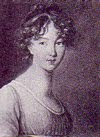
The Monmouth cap has been evolved over the last five centuries into the style many of us wear today. As Mara Riley explains, "Many of the surviving examples of the 17th and 18th century caps...were knitted larger than the finished size and then heavily felted to produce water-resistant headwear, though this treatment does not seem to have been universal...The term Monmouth Cap seems to refer generically to English knitted caps in the 18th century, some of which resemble Rutt's* cap and others which look more like modern stocking caps but without the ribbing." (http://marariley.net/knitting/caps.htm)
*A History of Hand Knitting"by Richard Rutt (1987)
The yellow one is knit in a vintage, unnamed 3 ply wool knit on 4.00mm needles, and somewhat resembles the 15th century acorn cap. The brim, however, rolls upwards. The light and dark grey ones are both knit on 3.25mm needles in 2 ply wools I bought so long ago I have forgotten their names. The dark gray one can be folded or pushed down at the top. The brim was folded over and knit into the body of the cap at 4 inches. This folding technique is found on some of the few extant caps such as the one in Heart of Oak* and the one worn by the late 17th century Gunnister Man. None of my caps have the *button* at the top or the loop on the brim found on many Monmouth caps.
*Heart of Oak - A Sailor's Life in Nelson's Navy by James P. McGuane (2002)


No comments:
Post a Comment